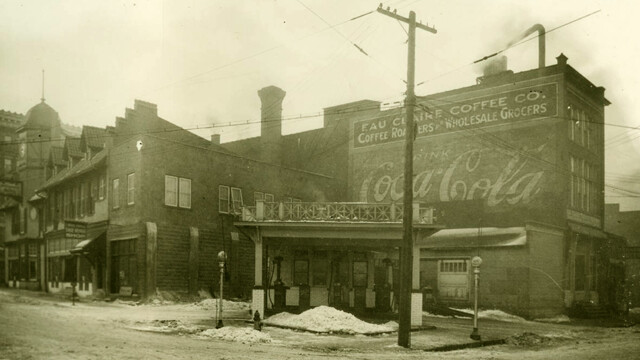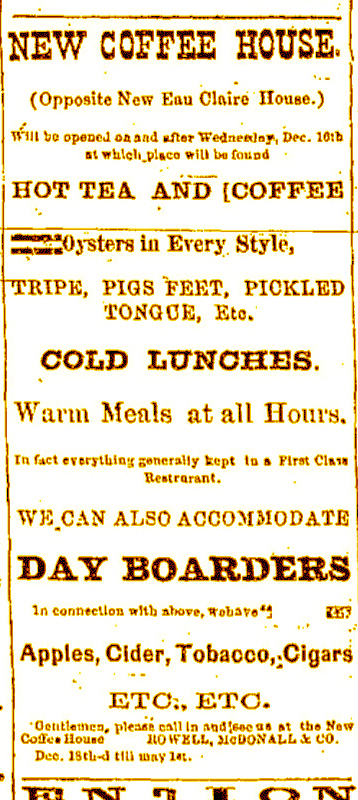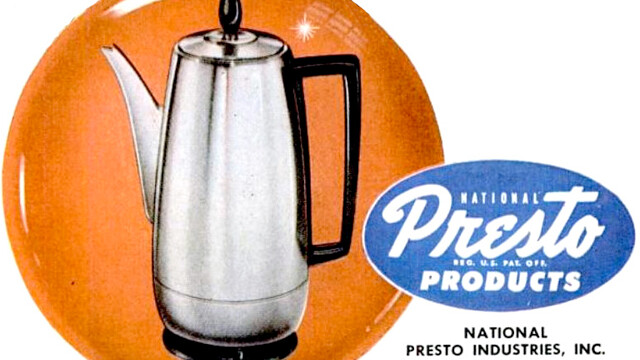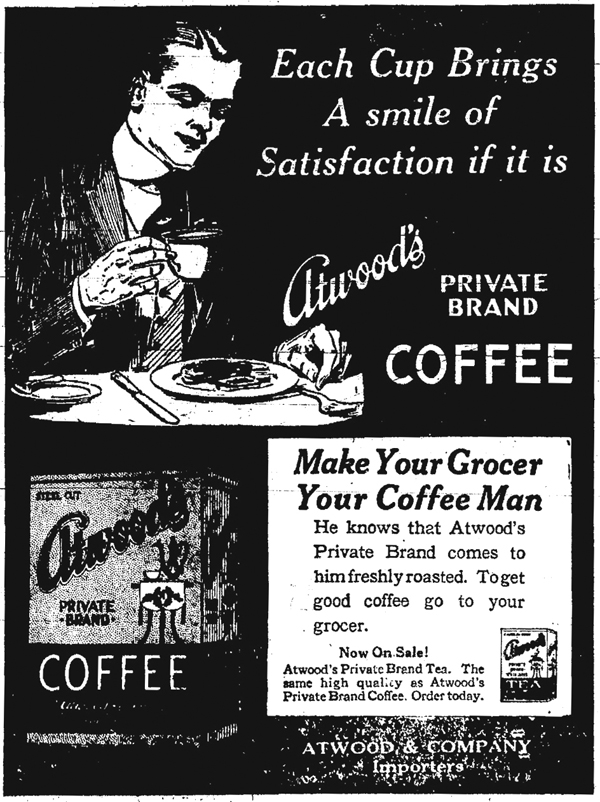History Served Hot: Evolutions in Coffee
Why do we love coffee so much here in the Chippewa Valley? It could be in the water – literally.

in the 1920s. Image: Chippewa Valley Museum
Long before words like “espresso” and “latte” entered everyday English, long before there was a coffee shop on every corner, and long before every gas station featured a “cappuccino” dispenser, coffee was an integral part of Chippewa Valley life.
Most locals know that the city got its name from the Eau Claire River, which in turn got its name because early French voyageurs discovered its water to be clear. (“Voici l’eau claire!” they exclaimed.) What many of us might not realize is that the Eau Claire River looked clear when compared with the Chippewa River, which – according to local historian Lois Barland – “was of a dark coffee color, being stained by needles of the tamarack trees which grow in the large swamps.” Perhaps the voyageurs’ perception of the Chippewa’s hue was prompted by longing for the cafés of Paris, but nonetheless it’s clear that coffee was in the water here – at least metaphorically.
Lumberjack Staple
Coffee-colored water isn’t appetizing to drink, but coffee-colored coffee is, of course. Even in the early days after Europeans’ arrival in the Chippewa Valley, the beloved beverage made of roasted beans was a staple. During the first few years of permanent settlement in the tiny community of Eau Claire during the 1850s, coffee was among the few staples residents stockpiled for the long, cold winters – an impulse that coffee lovers in our frigid climate can still relate to. Coffee was particularly important for the lumberjacks who felled the region’s white pines. Accounts of logging camp life describe coffee as a necessity, with the cooks rising long before sunrise to get coffee brewing by 4am, to be served alongside hearty breakfasts of biscuits, doughnuts, and salt pork.
By 1875, Eau Claire was home to at least one coffee house, located opposite the Eau Claire House, a hotel at the corner of Eau Claire and Barstow streets. In the pages of the Daily Free Press the Coffee House – that seemed to be its only name – advertised hot tea and coffee, as well as specialties such as tripe, pigs feet, and pickled tongue.
The menu was even more unusual at another Eau Claire business that called itself a “coffee house.” Apparently the latter establishment, which was busted by police in November 1875, was what the Free Press described as a “house of ill fame” – i.e., a brothel. The proprietor, a woman name Duntly, was fined $7. The next month, she was brought before a judge again, this time with “three young bloods who were found hanging around the premises.” The newspaper described the courtroom scene thusly: “The madame appeared before Judge Latimer with a tear in her eye and a faithful promise that she would vacate the city within a week, whereupon the parties were dismissed.” Future editions of the newspaper don’t indicate whether Madame Duntly really left town – or if the “coffee house” continued to carry the same connotation as “cathouse” in the Chippewa Valley.
Meeting Places

As Eau Claire expanded and matured, so did its taste for coffee. Grocers Hume & Rowe, who operated at the corner of Water Street and Fifth Avenue, boasted in an 1880 newspaper ad about their broad range of coffees, “from the lowest grade of Rio to the Choicest Mocha,” which ranged in price from 12.5 to 40 cents a pound. “Ground Coffee we make a specialty,” the grocery store proclaimed, “and our trade has increased so fast that we are making arrangements to put in a Roaster and Coffee-Mill, when we can promise you fresh Coffee every morning for breakfast.”
In the late 19th and early 20th century, numerous coffee shops were operating in the city, and some of them seemed to serve the same purpose they had for centuries in Europe: allowing ideas to brew by providing meeting places for civic and political organizations. For example, the Scandinavian Coffee House and Reading Room, 414 Galloway St., was a gathering place for everything from ski club meetings to political caucuses for Prohibition candidates.
Many other coffee houses dotted the community during that era. Among them were the Ideal Restaurant & Coffee House, on what is now Putnam Street near the Omaha railroad depot; Home Tea Co. on North Barstow Street; Syverson’s coffee shop, on Bellinger Street; and the Java Coffee Co. on Fulton Street. In 1920, the city saw the establishment of the Eau Claire Coffee Co., located in the Schlegelmilch building at 121 S. River St. (what’s now called Graham Avenue). The company distributed coffee and other grocery goods.

Making It for Millions
Eau Claire-based National Presto Industries may be best known for making pressure cookers and Salad Shooters – not to mention ammunition and adult diapers these days – but the company also has been producing coffee makers for almost 60 years. Back in 1953, then-president L.E. Phillips announced that the company would begin to market an automatic coffee maker. According to an official company history, in 1958 Presto “introducing the world’s first automatic, submersible stainless steel coffee maker.” Like a stovetop percolator, Presto’s product could brew tasty coffee and keep it at the right temperature, but it had the advantage of being fully washable, thus eliminating undesirable aftertaste. (Eat your heart out, Mr. Coffee!)
More than half a century later, coffee makers remain part of the Presto product lineup: The company still makes classic-looking stainless steel six- and 12-cup percolators as well as the single-cup MyJo coffee maker, a simple, slick, and portable device that allows users to brew java with a K-Cup.
The Espresso Era
For most of the 20th century, coffee was treated as a commodity by American consumers, who chose their (usually ground, often instant) coffee based on price or brand recognition. There were always coffee shops, of course, but they tended to be short-order restaurants where the java came in one style: from a carafe boiling away all day on a burner.
That began to change, at least in big cities in the 1970s and ’80s, when latter-day coffee shops began proliferating. (For example, the mega-chain Starbucks was founded in 1971.) As with many trends, what started on the coasts took a while to reach the Midwest. But the coffee craze finally hit the Chippewa Valley on April 2, 1991, when Eric Nelson opened the Coffee Grounds in London Square Mall.

“I didn’t want to open it up on April 1 because people would probably think it was a joke that we were opening a coffee shop,” says Nelson, and he’s only partly kidding: He estimates that at the time there were fewer than 10 such coffee shops in Wisconsin. Nelson’s taste for quality coffee began during his college years in Madison in the early 1980s, when coffee houses like Steep and Brew and Victor Allen’s were appearing. “Back in the late 1980s was the resurgence of people caring what was in the cup,” he says. “It wasn’t just Folgers, it wasn’t just Sanka.”
The original Coffee Grounds sold espresso-based drinks, scones, and muffins, as well as brewing equipment and 30 or 40 kinds of roast coffee, most of them flavored. “It was a constant struggle,” Nelson says of the early years. “People didn’t know what an espresso was. People didn’t know what a cappuccino was. … Every day someone would come in and order an espresso, and you’d make it and sit it down in front of them, and they’d say, ‘That’s it?’ ”
The business began to grow, however, and soon it had competition. Racy D’Lene’s Very Coffee Lounge opened on Riverside Avenue in 1993 and began catering largely to a college crowd that, due to drinking-law changes in the 1980s, couldn’t socialize in bars anymore. The next year, Acoustic Café brought espresso drinks, sandwiches, and live music to South Barstow Street. Many more – including Seattle Pride, Latte, and Gloria Jean’s – followed in the next few years.
Nelson relocated the Coffee Grounds to Mall Drive in 1996, and expanded the business to include more wine, specialty foods, beer, and a walk-in cigar humidor. (The business moved again in April to 4212 Southtowne Drive.) Coffee drinks, however, remained a mainstay. “Once people understand coffee, learn coffee, and taste good coffee, they want that,” Nelson says. And, even though they’re competition, Nelson says he has welcomed the proliferation of coffee shops across the Valley where people can converse and collaborate over steaming cups.
Scott Rogers, former proprietor of Gloria Jean’s in Eau Claire, agrees that coffee houses fill an important social niche. “They’ve talked about coffee shops being a ‘third place,’ ” he says, referring to the sociological idea that people need a familiar location to congregate that’s neither home nor work. Scott and his wife, Shirley, took over the Gloria Jean’s franchise in 2004 and closed the store early this year. During that decade, the culture of coffee became even more entrenched in the Valley, with the arrival of heavyweights like Starbucks and Caribou. Still, Scott says, it’s hard to say whether the market has been saturated. Coffee, he opines, is an “affordable luxury.” Rogers links the rise in coffee’s popularity to the overall “foodie” movement of recent years: Just as they like to know who raised their chickens or cut their kale, contemporary consumers are interested in who cultivated their coffee on which tropical mountainside.
Nelson agrees: “I’m happy to see coffee evolving like that, where people can learn about it and enjoy it like a really good glass of wine or beer.”

